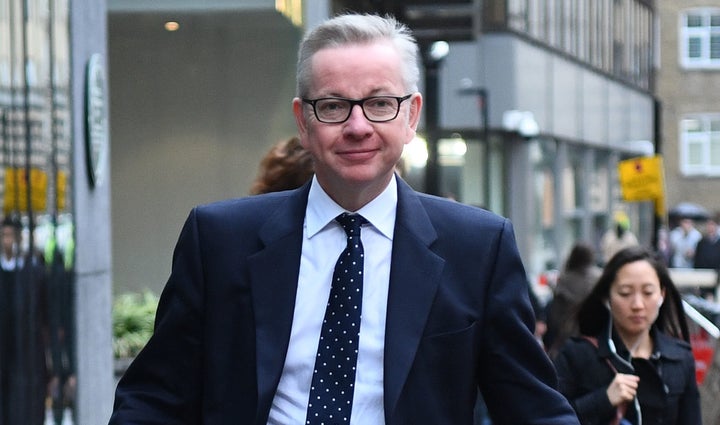Michael Gove has decided not to resign from Theresa May’s government, as the prime minister fights for her political life.
The environment secretary had been rumoured to be on the brink of quitting in protest at the proposed Brexit deal.
Asked this morning if he had confidence in the prime minister, he told TV cameras: “I absolutely do.”
Fresh speculation about a leadership challenge was fuelled on Friday morning as it was revealed all Conservative Party Whips had been ordered to cancel constituency engagements and return to Westminster.
But HuffPost UK understands that the threshold of 48 letters from MPs demanding a no confidence vote in May has not yet been reached.
May defended her position this morning as she took questions from members of the public on LBC’s morning radio call-in show.
But she could not guarantee she had the support of the DUP, who prop up her minority government. “When this vote comes back every individual MP will decide how they will vote, whether they are DUP, Conservative, Labour, all parties within the House of Commons,” she said.
More Tory MPs, including Jacob Rees-Mogg, have gone public with demands that she quit. The calls followed the resignations of Brexit secretary Dominic Raab and work and pensions secretary Esther McVey, both of whom resigned from Cabinet just hours after May presented the draft deal for the first time.

On Friday, after a bruising two days for May, Westminster was awash with speculation over whether a no confidence vote in May’s leadership was on the horizon.
Under the Conservative Party rules, a no confidence vote is triggered once 15% of MPs write letters to the current chair of the party’s governing 1922 committee, Graham Brady. There are 316 Conservative MPs in parliament, so it would take 48 letters to do the job.
Should the prime minister contest the no confidence vote, it would go to all Tory MPs and May would need the support of at least half – 159 – to stay in power.
May’s political future hung in the balance following the publication of her 585-page Brexit deal, which will provide the basis of a legally binding treaty for the UK’s exit from the European Union. It covers the future rights of EU citizens living in the UK and UK nationals in the EU, the UK’s £39 billion “divorce” settlement, as well as protocols on Gibraltar and the UK sovereign base areas in Cyprus.
It also provides for a transition period after the UK leaves in March 2019 running to the end of 2020, with the option of a one-off extension if more time is needed to conclude an agreement on the future relationship.
Crucially it also covers the so-called “backstop” intended to ensure there is no return to the hard border between Northern Ireland and the Republic if negotiations on the future relationship have still not been completed.
Former Brexit secretary David Davis – who quit in July over May’s Chequers plan for leaving the EU – said it was still possible to reopen negotiations with Brussels.
“It is a dreadful proposal, it really doesn’t fly by any measure. It is not a deal we should accept,” he told the BBC Radio 4 Today programme.
But a former permanent secretary at the Foreign Office, Sir Simon Fraser, dismissed Mr Davis’s claim that it was still possible to reopen negotiations with the EU.
“David Davis was a terrible Brexit secretary. He could hardly be bothered to go to Brussels and rapidly lost respect there,” he wrote on Twitter.
